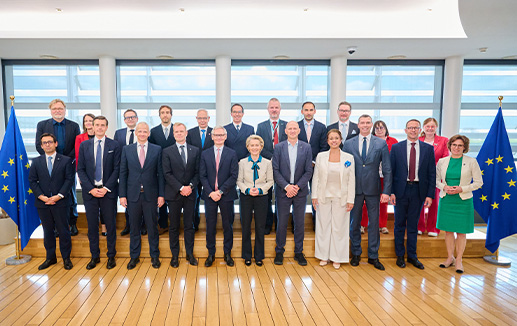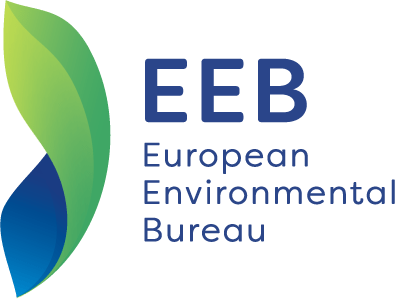EU Strategic Dialogue on Chemicals: A high-level discussion highlights urgent need for transformation, not deregulation
A petit comité high level meeting for a strategic dialogue on the future of the EU’s chemicals policy took place yesterday, chaired by President Ursula von der Leyen, with Commissioners Séjourné and Roswall, the Directors-General of DG GROW and DG ENV, and the Director of ECHA. The European Environmental Bureau stood as the sole environmental NGO present, speaking up for people and the planet in shaping the future of Europe’s chemical industry. Only two other civil society organisations, BEUC and ETUC, were at the table, in stark contrast to the 15 representatives from the chemical industry.

The meeting revealed a clear tension between industrial demands for public subsidies, cheaper energy, and regulatory rollbacks, and the Commission’s ongoing commitment to the European Green Deal. President von der Leyen reaffirmed: “The status quo will not be the future. We must be at the forefront,” and, regarding the European Green Deal, she reiterated: “I will stay the course.” She rightly identified homegrown renewables as the key to long-term energy security and affordability.
Patrick ten Brink, EEB Secretary General, said: “It’s time we stop taking decades to regulate what takes weeks to market. Strengthening REACH, banning harmful substances, and investing in transparency, traceability, and safer alternatives will build a healthier, circular, more resilient, and economically future-proof Europe — and help prevent future scandals like those caused by PFAS.”
The EEB urges the European Commission to accelerate the shift towards a carbon-neutral, circular, zero-pollution, and toxic-free chemicals sector. The transformation must be underpinned by environmental and social conditionalities and a clear 2040 transition roadmap.
The chemical industry is a significant contributor to climate change and harmful chemical pollution that affects human health —yet it remains one of the biggest blind spots in climate policy. Globally, the sector emits an estimated 3.3 billion tonnes of CO₂ each year—three times more than aviation—and is the largest industrial energy consumer, using 60% of Germany’s LNG. Moreover, substances like PFAS —so-called “forever chemicals”— massively contaminate European water and soil leading to severe health problems including cancer and damage to reproductive and immune systems, among others.
The European Union stands at a pivotal point in shaping its chemical regulatory policies. The European Commission has promised to deliver a Chemicals Industry Package including the simplification of REACH and clarification on PFAS. The EEB welcomed this commitment but warned that the direction must be forward-looking and transformative—not a return to outdated models.
Tatiana Santos, EEB Head of Chemicals Policy, said: “Europe’s failure to regulate PFAS is written in our blood. We can’t let that legacy continue. Simplification must mean faster decisions—not weaker protections. Smart, strengthened regulation -not deregulation -is the real driver of competitiveness, innovation, and public trust. By ensuring information on hazards of chemicals along the supply chain, making toxic-free products the rule, not the exception, and enforcing accountability, Europe can secure a healthier, circular more resilient, and economically sustainable future driven by safer alternatives.”
However, the EU’s current chemicals regulation, REACH, is slow and ineffective— it takes weeks to bring a chemical to market, but decades to ban harmful substances. Chemical industry non-compliance with information obligations remains alarmingly high, resulting in authorities and companies lack vital information on chemical hazards and uses, hampering safety, innovation, and recycling efforts.
Contrary to industry claims that REACH is too burdensome, the chemical sector has flourished under regulation. Since REACH’s adoption, the sector’s revenue grew to a record €872 billion in 2022, with the EU remaining the world’s top chemical exporter and boasting a Q2 2024 trade surplus of €59.3 billion. According to the EU chemicals industry lobby, CEFIC, all environmental regulations together account for just 3% of competitiveness costs. CEFIC highlights energy and fossil feedstocks as the true constraints for the chemical sector’s competitiveness, accounting for 30-40%.
The coming weeks will be critical for the future of EU chemicals regulation, as the long-awaited REACH revision reaches a decisive stage. As the European Commission prepares its chemicals package, the direction it takes will determine whether Europe remains a global leader in safe, clean innovation—or falls behind, with environmental, health, and economic costs spiralling. During yesterday’s meeting, President Ursula von der Leyen announced that another high-level strategic roundtable will follow before the summer. The EEB stands ready to support bold and fair measures that truly serve the public interest.
ENDS
Contact information
Beatriz Ortiz Martinez, Senior Communication Officer for Chemicals, European Environmental Bureau, beatriz.ortiz-martinez@eeb.orb

